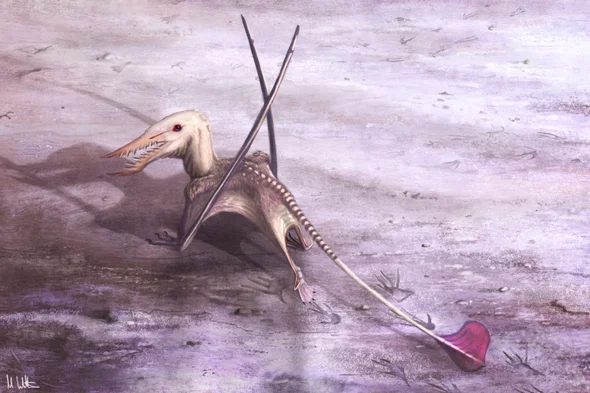Since the discovery of pterosaur remains more than 200 years ago, researchers have been unable to establish how early members of this genus of flying reptiles, from the Triassic or Jurassic periods, walked on land. However, the discovery of these pterosaurs' initial footprints in southern France disproves theories that they were clumsy or sprawling walkers who struggled on land or that they walked on their hind legs like birds.
Late Jurassic pterosaur similar to Rhamphorhynchus muensteri (pictured) left footprints on a beach that are now revealing how early pterosaurs moved on the ground. Credit: Mark Witton
A group of pterosaurs known as pterodactyloids, which were widespread in the Late Jurassic and throughout the Cretaceous, left fossilized pterosaur footprints at more than 30 sites around the world in recent years. Some of these latter pterosaurs, like Pteranodon and Quetzalcoatlus, became as large as small airplanes and had short tails and toothless mouths.
Now, French paleontologists reveal in Geobios that they have discovered the tracks of pterosaurs that are not pterodactyloid. The early, less specialized pterosaurs in this vast group, such the fish-eating Rhamphorhynchus, most of which still retained teeth and long tails, are also included.
According to paleontologist Michael Habib of the University of Southern California, who was not involved in the new discovery, "[Until now] these earlier pterosaurs have, strangely, never left any trackways. In comparison, pterodactyloid tracks number in the thousands. Due to this, experts have previously suggested that early pterosaurs had poor ground mobility."
The new discovery was located at a location named Pterosaur Beach in Crayssac, France. Some scientists have even concluded that these creatures "were unable to walk on ground and were only climbers," according to paleontologist and lead study author Jean-Michel Mazin. He continues, "so when we discovered the first unambiguous non-pterodactyloid footprints, we were very happy. Researchers had long searched for fossils to confirm the walking ability of these animals."
The alternating front and back footprints from excavations from 2000 to 2014 comprise four trackways that are each just over one meter long. The pterosaurs, who left the individual footprints, were roughly the size of small birds, weighed barely 100 grams, and walked on all fours. The footprints are each about three centimeters long. By examining the size, depth, and spacing of the footprints, paleontologists can infer the size of the creatures that left them.
Although Crayssac is well inland today, it was a mudflat on the shore of a shallow sea 150 million years ago, during the Late Jurassic. In the mud and sand, animals such as dinosaurs, pterosaurs, turtles, crocodiles, and crabs made imprints that were later preserved as fossils.
The newly discovered tracks were initially mistaken for those of pterosaurs by Mazin and his co-author Joane Pouech, who works with Mazin at a museum in Pterosaur Beach. But the scientists only understood the full implications of their discovery when they noticed that the creatures that had abandoned them had five toes on their back foot. According to Mazin, pterodactyloids had just four toes on their hind feet, but non-pterodactyloids had five.
Additionally, the trackways showed that, unlike their later relatives, these early pterosaurs' front feet had toes that directed forward rather than out to the side. These novel trackways, according to Mazin, "clearly showed that non-pterodactyloids were quadrupedal and good walkers even though they are morphologically very different from pterodactyloid tracks."
Habib notes that Mazin and Pouech "discovered and described a beautiful fossil trackway that was clearly left by one of the earlier types of pterosaurs," and that there is no indication from the footprints that these creatures were incapable of moving quickly on the ground. "Their discovery refutes the notion that early pterosaurs were incapable of efficient running or walking."
The fossil is the "final nail in the coffin of the idea that basal pterosaurs were awkward and clumsily walking around—and definitely of the idea that early pterosaurs might have been bipedal," according to Elizabeth Martin-Silverstone, a pterosaur expert at the University of Bristol in England who was not involved in the research.Not only did they move rapidly and elegantly, but they also walked on all fours, she continues.
Small pterosaurs walking adeptly on all fours left a series of trackways, such as this one, on a French beach about 150 million years ago. Credit: Jean-Michel Mazin PaleoAquitani
It has been a long and painful wait to find proof of how their older, long-tailed predecessors walked on the ground, according to Mark Witton, a pterosaur expert at the University of Portsmouth in England. Although the earliest known tracks from pterodactyloid pterosaurs were discovered in the 1950s. He did not participate in the actual study, but he examined the publication outlining the new research. "This is one of those 'holy grail' discoveries that we've long needed to answer a list of questions about early pterosaur biology," he claims. This represents a significant advance for pterosaur science.
According to Witton, the discovery will drastically alter perceptions of early pterosaurs, forcing paleoartists to start over and update their previous depictions of these creatures. "Ideas of them being bipeds or sluggish sprawlers are out the window," he continues.
There is a possibility that more early pterosaur trackways will be discovered now that fossil hunters are more aware of what to search for. These findings could provide further information about posture, speed, and gait. But because these animals didn't come down to the ground very often, it's possible that these specimens are so uncommon, making them treasured finds. "They seem really less common in the track fossil record, maybe because they were walkers but also climbers or cliff dwellers" like certain seabirds do today, claims Mazin.
Habib argues that non-pterodactyloids were capable of walking, even if they only did so occasionally. He speculates that they might have preferred to climb in trees to avoid predators. The majority of Triassic and Jurassic pterosaurs were small in size and would have had a wide variety of ground-based predators.








